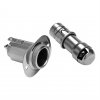I do electronics for living and this should be the first thing I should have checked :-D
The battery voltage is 700mV!
Do I need to get a charger with "trickle" feature to recover the dead battery, or I need a new one?
Is it just a normal 12V car battery?
Reasons: Last fall, my son left the fish finder on, maybe the CD play too, then I took the boat out, had hard time to start, and start, and start, after I got her running, I only drove at pretty low speed for only about 5 minutes. so the battery was pretty much drained at that time. And the fish finder and CD player have been connected to the battery in the last 6 month, even they were turned off. Bad sleep mode design may still take uA current, which totally killed it.








